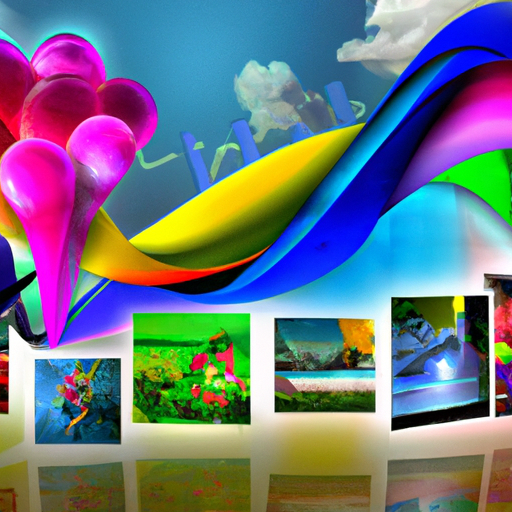Imagine a world where digital artwork is bought and sold like physical paintings or sculptures – where ownership is verified and art lovers can display their pieces with pride. This is the exciting reality that non-fungible tokens (NFTs) are bringing to the forefront of the art and collectibles market. In this article, we will explore the rise of non-fungible tokens, their unique characteristics, and how they are revolutionizing the way we buy, sell, and appreciate digital art. Get ready to dive into the fascinating world of NFTs and discover the possibilities they hold for artists, collectors, and enthusiasts alike.
Exploring the Rise of Non-Fungible Tokens
What are Non-Fungible Tokens?
If you’ve been hearing a lot about Non-Fungible Tokens (NFTs) lately and find yourself wondering what they are and why they’ve become so popular, you’ve come to the right place. Non-Fungible Tokens, also known as NFTs, are unique digital assets that represent ownership of a specific item or piece of content, such as artwork, music, videos, or even virtual real estate. Unlike cryptocurrencies like Bitcoin or Ethereum, NFTs cannot be exchanged on a one-to-one basis, as each token holds its own distinct value and characteristics.
The Advantages of Non-Fungible Tokens
The rise of NFTs can be attributed to their numerous advantages. One of the main advantages is the ability to prove ownership and authenticity. With traditional digital content, it can be challenging to prove that you are the legitimate owner. However, NFTs provide a verifiable and transparent way to confirm ownership, thanks to the power of blockchain technology.
Another significant advantage of NFTs is the potential for creators to monetize their digital creations. Artists, musicians, and content creators can sell their work directly to their fans and receive royalties whenever their NFTs are bought, sold, or traded. This provides a new revenue stream for creators, allowing them to bypass traditional middlemen and take control of their own monetization.
The Growth and Popularity of Non-Fungible Tokens
The growth and popularity of NFTs have been astonishing over the past year. It started gaining significant attention in early 2021 when the artist Beeple sold an NFT artwork for a record-breaking $69 million at a Christie’s auction. This newfound interest sparked a frenzy in the market, with collectors and investors rushing to get their hands on unique digital assets.
The accessibility of NFT marketplaces and the ability to trade NFTs easily have contributed to the rapid growth. Platforms like OpenSea, Rarible, and SuperRare have made it simple for anyone to buy, sell, and trade NFTs, creating a vibrant and active ecosystem for digital collectibles.
Use Cases for Non-Fungible Tokens
NFTs have found applications in various industries and use cases beyond just art and collectibles. Gaming, for example, has seen a significant integration of NFTs. Players can now purchase and trade unique in-game items, characters, and even virtual land, bringing a new level of ownership and value to the gaming experience.
In addition to gaming, NFTs have also made their way into the music industry. Musicians can release limited edition albums or singles as NFTs, offering exclusive perks and rewards to their most dedicated fans. This not only provides additional revenue for artists but also strengthens the bond between artists and their audience.
Another fascinating use case for NFTs is the tokenization of real-world assets. Companies and individuals can tokenize physical assets such as real estate, rare collectibles, or intellectual property. By representing these assets as NFTs, they can be easily bought, sold, and traded on blockchain platforms, enhancing liquidity and enabling fractional ownership.
The Role of Blockchain in Non-Fungible Tokens
Blockchain technology plays a crucial role in the existence and functionality of NFTs. NFTs are typically built on blockchain networks such as Ethereum, which provide the necessary infrastructure for creating, storing, and trading these digital assets. The decentralized nature of blockchain ensures that NFTs are traceable, immutable, and secure.
The use of blockchain also eliminates the risk of counterfeit or fraudulent NFTs. Every transaction involving NFTs is recorded on the blockchain, creating a permanent and transparent ledger of ownership. This transparency is essential for establishing trust in the NFT market and preventing unauthorized duplication or manipulation.
Challenges and Concerns with Non-Fungible Tokens
While the rise of NFTs has been met with enthusiasm, there are also several challenges and concerns surrounding this emerging technology. One of the main concerns is the environmental impact of NFTs. As most NFTs are built on the Ethereum blockchain, which consumes a significant amount of energy, the carbon footprint associated with NFT transactions has raised concerns about sustainability.
Another challenge is the potential for copyright infringement. With the ease of minting and selling NFTs, there is a risk that individuals could create and sell NFTs of copyrighted material without permission from the original creators. This raises questions about intellectual property rights and the need for better regulation and protection for artists and content creators.
The Future Outlook for Non-Fungible Tokens
Despite the challenges, the future outlook for NFTs remains promising. As more industries and creators recognize the potential of NFTs, we can expect to see increased adoption and integration into various aspects of our digital lives. The technology behind NFTs is still in its early stages, and there is room for innovation, improvement, and scalability.
As blockchain technology continues to advance, we may see more sustainable and energy-efficient solutions for NFTs. Additionally, the development of interoperability protocols could enable NFTs to be seamlessly transferred across different blockchain networks, increasing their value and utility.
Investing in Non-Fungible Tokens
For those interested in investing in NFTs, it’s essential to approach it with caution and do thorough research. The NFT market can be highly speculative and volatile, with prices fluctuating rapidly. It’s crucial to understand the underlying value and potential of the NFT you are considering, as well as the reputation and credibility of the creator.
Furthermore, diversification is key when investing in NFTs. Instead of putting all your funds into a single NFT, consider spreading your investments across different types of digital assets and creators. This can help mitigate risk and increase your chances of finding undervalued gems in the market.
NFTs in the Art World
NFTs have made a significant impact on the art world, revolutionizing the way artists create, sell, and display their work. Traditionally, artists have relied on physical galleries and auction houses to showcase and sell their artwork. However, with the rise of NFTs, artists now have a digital platform to directly connect with their audience and sell their art to a global market.
The introduction of NFTs has also brought new opportunities for emerging artists who may not have had access to traditional art markets. Artists can now showcase their digital creations, gain recognition, and monetize their work without the need for intermediaries. This democratization of the art world has opened doors for artists from diverse backgrounds and has the potential to reshape the industry.
NFTs in the Gaming Industry
Another industry that has embraced the potential of NFTs is the gaming industry. NFTs have revolutionized the concept of ownership in games by allowing players to truly own and trade virtual assets. In many traditional video games, players invest time and money in acquiring valuable in-game items, but they have no control over these assets outside of the game. With NFTs, players can now have true ownership and autonomy over their virtual possessions.
Furthermore, NFTs have introduced the concept of play-to-earn, where players can earn real-world value through their in-game activities. This has opened up new possibilities for gamers to monetize their skills and dedication. Additionally, the integration of NFTs has sparked creativity in game development, as developers can create unique and scarce virtual assets that hold real value for players.
In conclusion, Non-Fungible Tokens have rapidly gained popularity due to their unique properties and advantages. From art to gaming, NFTs have found applications in various industries, providing new opportunities for creators, collectors, and investors alike. As the technology advances and the market matures, we can expect to see further innovation and integration of NFTs, shaping the future of the digital economy. So keep an eye on this exciting space, and who knows, you might just find yourself exploring the world of NFTs sooner than you think!

